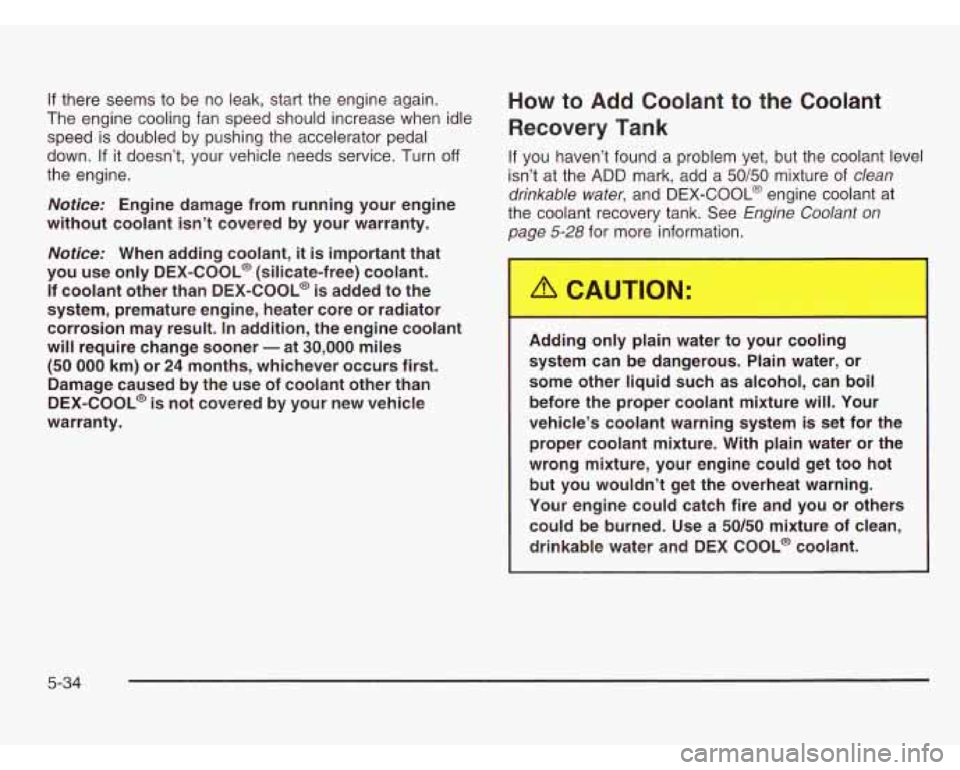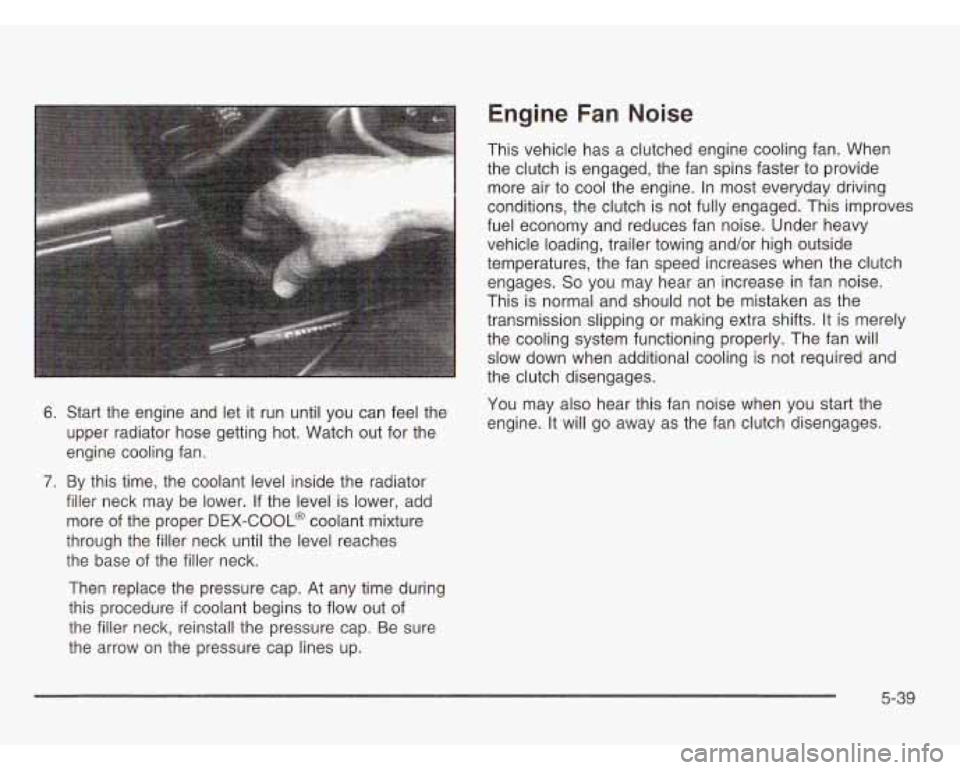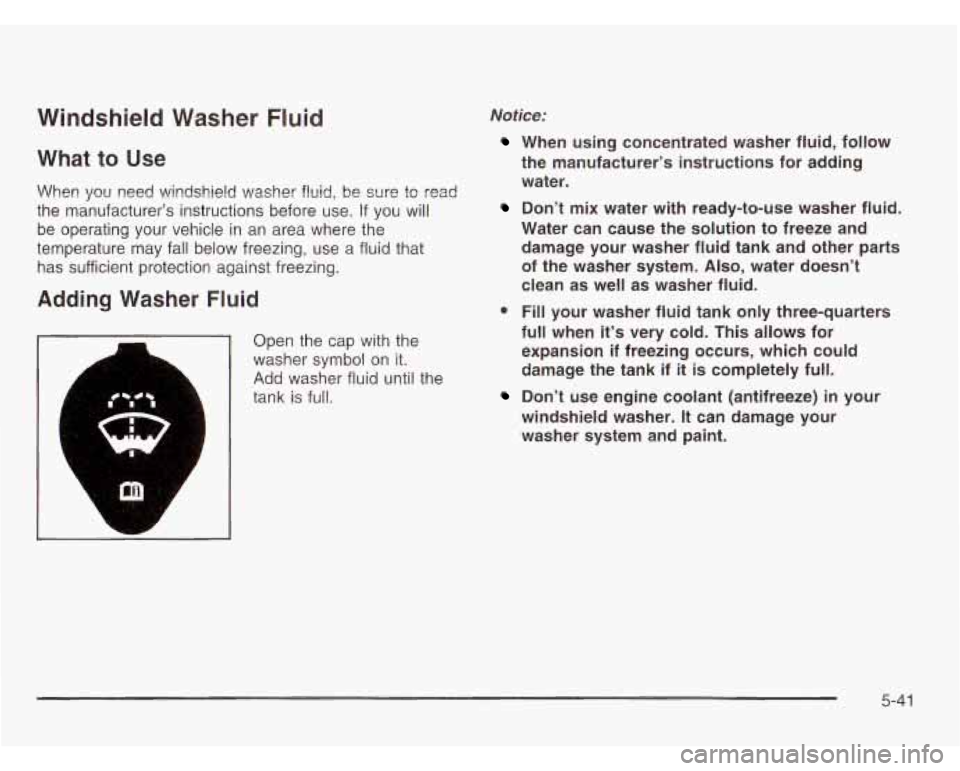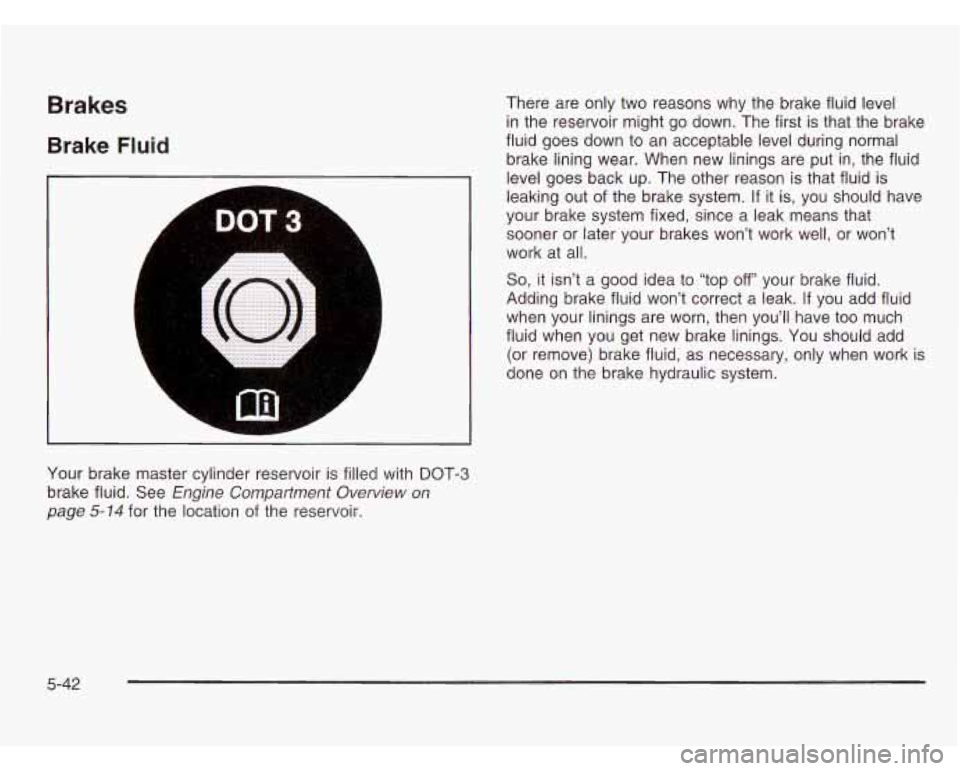Page 250 of 386
Cooling System
When you decide it’s safe to lift the hood, here’s what
you’ll see: The
coolant level should
be at the
ADD mark.
A. Coolant Recovery Tank
B. Radiator Pressure Cap
C. Engine Cooling Fan
If the coolant inside the coolant recovery tank is boiling,
don’t do anything else until it cools down. The vehicle
should be parked
on a level surface.
A
If it isn’t, you may have a leak at the pressure cap or
in the radiator hoses, heater hoses, radiator, water pump
or somewhere else
in the cooling system.
Heater and radiator hoses, and other engine
parts, can be very hot. Don’t touch them.
If you do, you can be burned.
Don’t run the engine if there
is a leak. If you run
the engine,
it could lose all coolant.
That could cause an engine fire, and you could be burned. Get any leak fixed before you drive
the vehicle.
5-33
Page 251 of 386

If there seems to be no leak, start the engine again. How to Add Coolant to the Coolant
The engine cooling fan speed should increase when idle
speed is doubled by pushing the accelerator pedal
Recovery Tank
down. If it doesn’t, your vehicle needs service. Turn off If you haven’t found a problem yet, but the coolant level
the engine. isn’t at the
ADD mark, add a 50/50 mixture of clean
Nofice: Engine damage from running your engine
without coolant isn’t covered by your warranty.
Notice: When adding coolant, it is important that
you use only
DEX-COOL@ (silicate-free) coolant.
If coolant other than DEX-COOL@’ is added to the
system, premature engine, heater core or radiator
corrosion may result.
In addition, the engine coolant
will require change sooner
- at 30,000 miles
(50 000 km) or 24 months, whichever occurs first.
Damage caused by the use of coolant other than
DEX-COOL@ is not covered by your new vehicle
warranty.
drinkable wafer, and DEX-COOL@ engine coolant at
the coolant recovery tank. See
Engine Coolant on
page 5-28 for more information.
Adding only p.,,n water to your coG...rg
system can be dangerous. Plain water, or
some other
liquid such as alcohol, can boil
before the proper coolant mixture will. Your
vehicle’s coolant warning system
is set for the
proper coolant mixture. With plain water or the
wrong mixture, your engine could get too hot but you wouldn’t get the overheat warning.
Your engine could catch fire and you or others
could be burned. Use a
50/50 mixture of clean,
drinkable water and DEX COOL@ coolant.
5-34
Page 252 of 386
Notice: In cold weather, water can freeze and crack
the engine, radiator, heater core and other parts.
Use the recommended coolant and the proper
coolant mixture.
You can be burned if you spill coolant on hot
engine parts. Coolant contains ethylene glycol and
it will burn if the engine parts are hot
enough. Don't spill coolant on a hot engine.
When the coolant in the coolant recovery tank
is at the
ADD mark, start your vehicle.
5-35
Page 255 of 386
3. Fill the radiator with the proper DEX-COOL@
coolant mixture, up to the base of the filler
neck. See
Engine Coolant on page 5-28 for more
information about the proper coolant mixture.
4. Then fill the coolant recovery tank to the ADD mark.
5. Put the cap back on the coolant recovery tank,
but leave the pressure cap
off.
5-38
Page 256 of 386

6. Start the engine and let it run until you can feel the
upper radiator hose getting hot. Watch out for the
engine cooling fan.
7. By this time, the coolant level inside the radiator
filler neck may be lower.
If the level is lower, add
more of the proper
DEX-COOL@ coolant mixture
through the filler neck until the level reaches
the base of the filler neck.
Then replace the pressure cap. At any time during
this procedure
if coolant begins to flow out of
the filler neck, reinstall the pressure cap. Be sure
the arrow on the pressure cap lines up.
Engine Fan Noise
This vehicle has a clutched engine cooling fan. When
the clutch is engaged, the fan spins faster to provide
more air to cool the engine. In most everyday driving
conditions, the clutch is not fully engaged. This improves
fuel economy and reduces fan noise. Under heavy
vehicle loading, trailer towing and/or high outside
temperatures, the fan speed increases when the clutch
engages.
So you may hear an increase in fan noise.
This is normal and should not be mistaken as the
transmission slipping or making extra shifts. It is merely
the cooling system functioning properly. The fan will
slow down when additional cooling is not required and
the clutch disengages.
You may also hear this fan noise when you start the
engine. It will go away as the fan clutch disengages.
5-39
Page 257 of 386

Power Steering Fluid
When to Check Power Steering Fluid
It is not necessary to regularly check power steering fluid
unless you suspect there is a leak in the system or
you hear an unusual noise. A fluid loss in this system
could indicate a problem. Have the system inspected
and repaired. See
Engine Compartment Overview
on page
5-14 for reservoir location.
How to Check Power Steering Fluid
Turn the key off, let the engine compartment cool down,
wipe the cap and the top of the reservoir clean, then
unscrew the cap and wipe the dipstick with a clean rag.
Replace the cap and completely tighten
it. Then remove
the cap again and
look at the fluid level on the dipstick.
The level should be at the
FULL COLD mark. If
necessary, add only enough fluid to bring the level up to
the mark.
What to Use
To determine what kind of fluid to use, see Part D:
Recommended Fluids and Lubricants on page 6-32.
Always use the proper fluid. Failure to use the proper
fluid can cause leaks and damage hoses and seals.
5-40
Page 258 of 386

Windshield Washer Fluid
What to Use
When you need windshield washer fluid, be sure to read
the manufacturer’s instructions before use. If you will
be operating your vehicle in an area where the
temperature may fall below freezing, use a fluid that
has sufficient protection against freezing.
Adding Washer Fluid
Open the cap with the
washer symbol on it.
Add washer fluid until the
tank is full.
Notice:
When using concentrated washer fluid, follow
the manufacturer’s instructions for adding water.
Don’t mix water with ready-to-use washer fluid.
Water can cause the solution to freeze and
damage your washer fluid tank and other parts
of the washer system.
Also, water doesn’t
clean as well as washer fluid.
0 Fill your washer fluid tank only three-quarters
full when
it’s very cold. This allows for
expansion
if freezing occurs, which could
damage the tank if
it is completely full.
Don’t use engine coolant (antifreeze) in your
windshield washer.
It can damage your
washer system and paint.
5-41
Page 259 of 386

Brakes
Brake Fluid
DOT3
. . . . . . . ..... . . . . . . . . ... .
. . . . . . . .
. ... . . . .
..
. . . . . . . . . . . , . , . . .
There are only two reasons why the brake fluid level
in the reservoir might go down. The first
is that the brake
fluid goes down to an acceptable level during normal
brake lining wear. When new linings are put in, the fluid
level goes back up. The other reason
is that fluid is
leaking out of the brake system.
If it is, you should have
your brake system fixed, since a leak means that
sooner or later your brakes won’t work well, or won’t
work at all.
So, it isn’t a good idea to “top off your brake fluid.
Adding brake fluid won’t correct a leak.
If you add fluid
when your linings are worn, then you’ll have too much
fluid when you get new brake linings. You should add
(or remove) brake fluid, as necessary, only when work is
done on the brake hydraulic system.
Your brake master cylinder reservoir is filled with DOT-3
brake fluid. See
Engine Compadment Overview on
page 5-14 for the location of the reservoir.
5-42